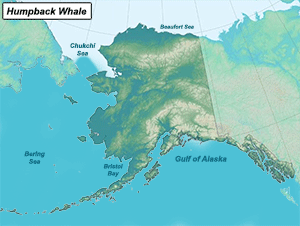- Megaptera novaeangliae
- yáay


Humpbacks always feed on small prey. In Alaska humpbacks feed on around a half-ton of krill, euphausiids, hooligan, capelin, herring or sand lance daily. An awesome sight to behold is humpbacks feeding by bubble netting, where whales dive under a school of fish swimming around them corralling them it bubbles as they release air from their spouts. Then they swim up through the center of the massive bubble corral with their ginormous mouths open, scooping up as much food as they can when all the sudden wide open mouths emerge from the water before closing and quietly sinking back below.
Bubble netting can often be observed in the waters around Juneau and Resurrection Bay.